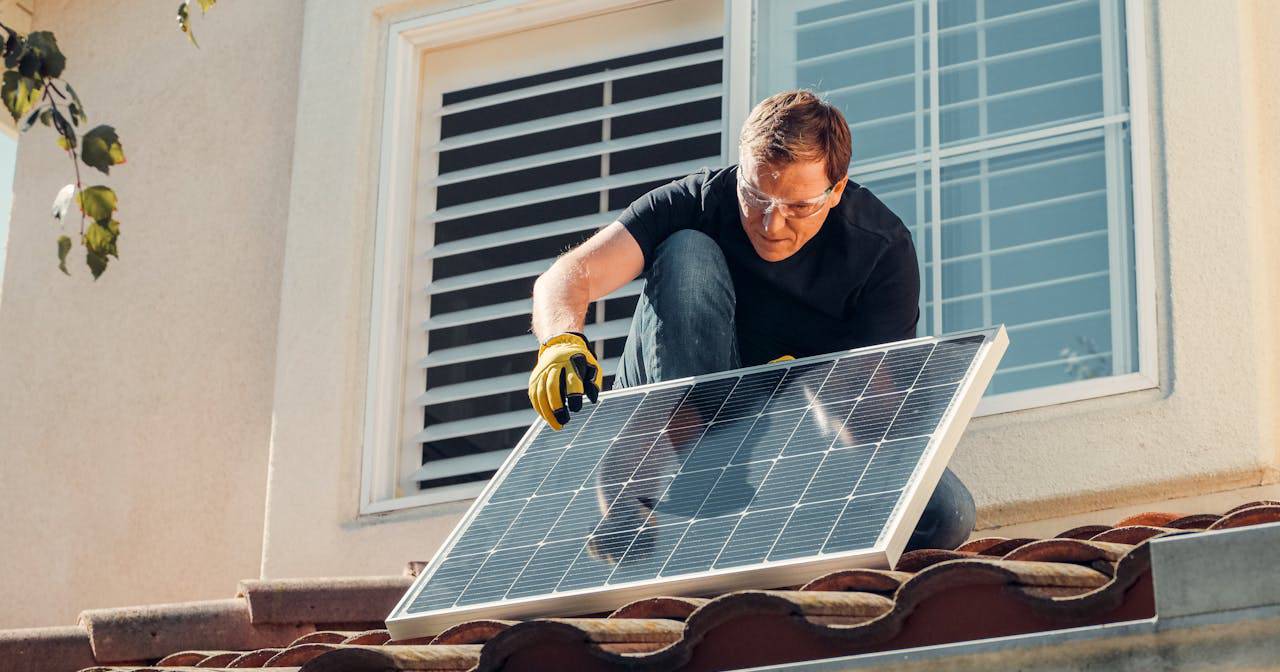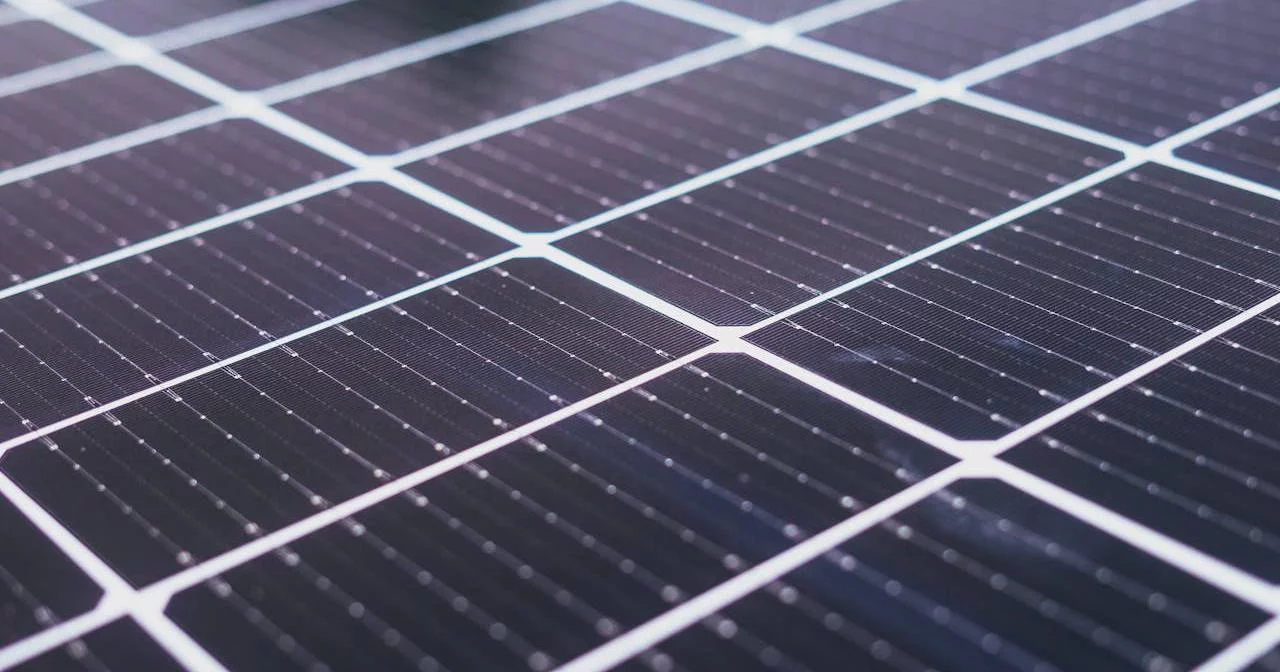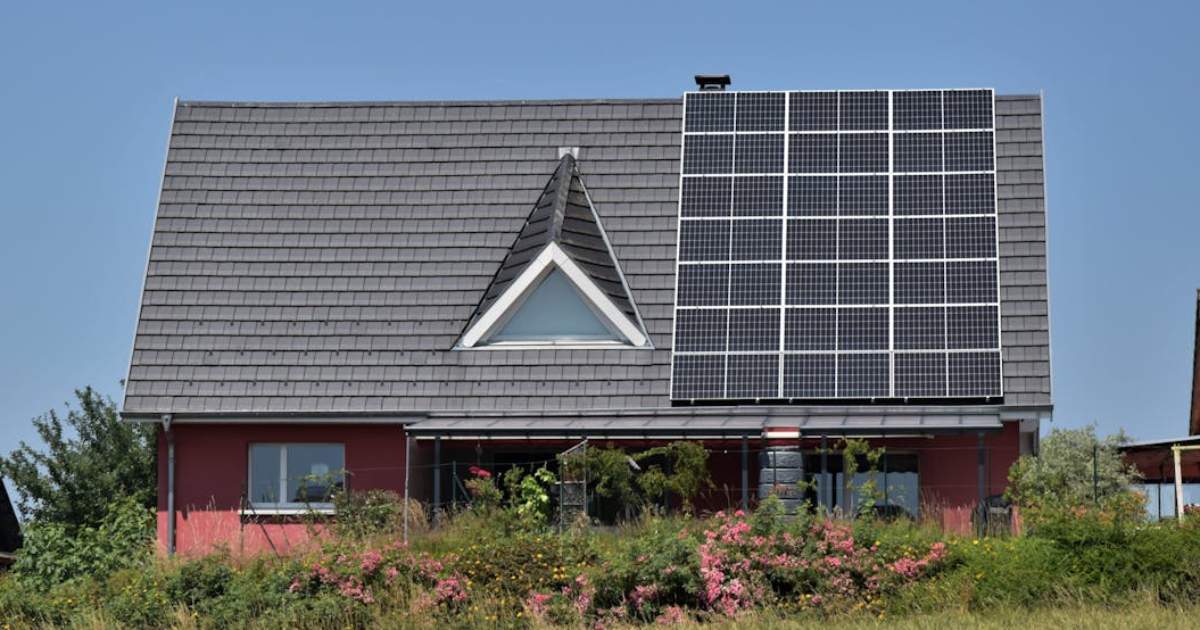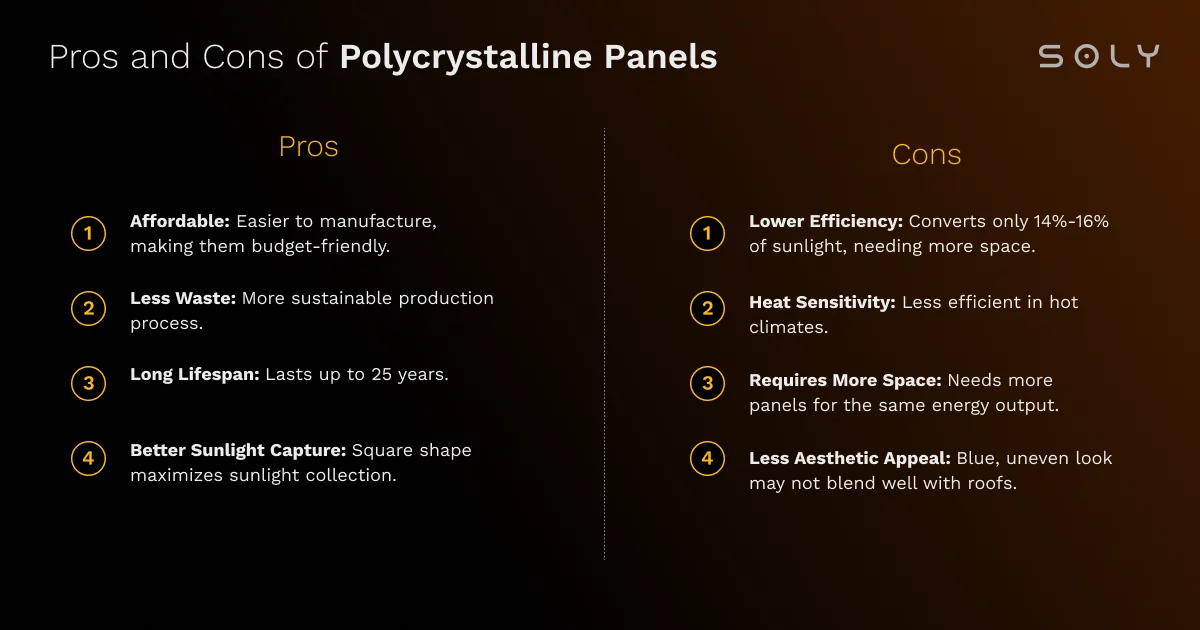Polycrystalline solar panels explained
Are polycrystalline solar panels the best choice for UK homeowners? At peak sunlight, polycrystalline panels produce 47.87 watts compared to 54.89 watts from monocrystalline solar panels, making them a budget-friendly option for those exploring different types of solar panels. But are they efficient enough to handle the UK’s often cloudy weather?

Polycrystalline panels are more affordable but slightly less efficient than monocrystalline ones, so understanding their pros and cons is crucial before deciding if they’re right for your home.
On this page, you’ll learn:
- What polycrystalline solar panels are and how they differ from other panel types.
- The benefits and drawbacks of polycrystalline solar panels for UK homeowners.
- What costs to consider for long-term savings, and more!
Let’s explore the details!
What is a Polycrystalline solar panel?
Polycrystalline solar panels are made by melting together multiple silicon crystals. This gives them a bluish colour and a somewhat grainy appearance. These panels are a more budget-friendly option compared to monocrystalline ones. Of course, this is thanks to their simpler manufacturing process.

While they aren’t as efficient, polycrystalline panels are still a solid choice for producing electricity, especially if you’re trying to save money on the cost. They work best in places that get plenty of sunshine and have enough space to install more poly solar panels if they need to.
How do Polycrystalline solar panels work?
Polycrystalline solar panels are quicker and cheaper to produce, which is why they cost less. The main difference lies in their structure. These panels are made from multiple silicon crystals. While this can slightly reduce their efficiency because the electrons have more boundaries to cross, advancements in manufacturing have improved their performance.
This balance between cost and efficiency makes polycrystalline panels a popular, budget-friendly choice for homeowners who want to make the switch to reliable solar PV systems without having to break the bank to do so.
For better understanding, we’ve broken the solar technology steps down for how poly panels are made below:
- Production Steps:
- Silicon Melting: Raw silicon is melted and crystallised into a large block.
- Cutting: The cooled block is sliced into thin discs.
- Cleaning and Coating: Discs are cleaned, and an anti-reflective coating is applied to enhance efficiency.
Why does crystal size matter?
Poly panels are made up of many smaller crystals of silicon, known as crystalline silicon. This creates more barriers for electrons to move through. In turn, this slows down the flow of electricity a bit, reducing their energy production compared to other types.
In contrast, monocrystalline panels have larger, single crystals that allow electrons to move more easily. This makes monocrystalline solar panels much more efficient.

Pros and cons of Polycrystalline solar panels
When it comes to polycrystalline panels, there’s some differences to take note of in the solar technology. In fact, monocrystalline solar cells and poly panels both have their own sets of pros and cons that we need to take a closer look at. Let’s take a look at the pros and cons of poly panels below:

Advantages
- ✅ Cheaper than monocrystalline solar cells: Polycrystalline panels are more affordable because they’re easier to make. This makes them a good choice if you want to save on the initial costs without sacrificing too much efficiency.
- ✅ Less waste: The simpler production process also means they produce less waste. This is a plus if you’re focused on sustainability.
- ✅ Similar lifespan: Even though they’re cheaper, polycrystalline panels can last just as long—up to 25 years.
- ✅ More surface area: Their square-shaped solar monocrystalline cells fit closely together. This helps to capture more of the sun’s rays with each panel.
Disadvantages
- ❌ Lower efficiency: Polycrystalline solar panels convert about 14%-16% of sunlight into electricity. Monocrystalline solar panels are slightly better averaging out at 15%-24%. This means polycrystalline panels may need more space to produce the same amount of power.
- ❌ Sensitive to heat: When installing solar panels, it’s important to know that these solar cells don’t perform as well in hot climates. So, these panels will lose their efficiency much faster than monocrystalline panels.
- ❌ More space required: Because they’re less efficient than monocrystalline cells, you’ll need more photovoltaic panels to convert sunlight that meets your energy needs. So, if you have limited roof space, this probably isn’t the best option for you.
- ❌ Appearance: Polycrystalline solar cells have a blue, uneven look that doesn’t blend as smoothly with most roofs compared to the sleeker, black monocrystalline panels.
Poly vs Mono solar panels: What’s the difference?
To help you better understand the differences between the two solar cells, here’s a comparison table showcasing the main differences between polycrystalline and monocrystalline solar panels:
Monocrystalline solar panel pros and cons
Here’s a breakdown of the pros and cons of monocrystalline solar panels when it comes to mono vs poly solar panels:
Pros
- ✅ High Efficiency: Monocrystalline panels are incredibly efficient. They convert more sunlight into electricity than most other types of panels.
- ✅ Space-Saving: Because of their higher efficiency, you need fewer panels to generate the same amount of power. This is perfect for homes that don’t have much roof space for a solar panel installation.
- ✅ Long Lifespan: Monocrystalline solar panels typically are built to last, these panels often have a lifespan of over 25 years.
- ✅ Performs Well in Low Light: Even on cloudy days, these solar cells can still generate a good amount of power, which is perfect in areas like the UK.
- ✅ Sleek Look: Their black finish gives them a clean, modern look that blends well with most roofs.
Cons
- ❌ Higher Cost: Monocrystalline panels tend to be more expensive because they use high-purity silicon and require a more complex manufacturing process.
How much do Polycrystalline solar panels cost?
Polycrystalline panels typically cost around £0.90 per watt. This makes them a more affordable option for homeowners. For a small residential setup in the UK, such as a 3kWh system, you’d need about 6 panels. Each poly solar panel produces 435W, bringing the cost to £2,349 for the panels alone.
While polycrystalline cells aren’t as efficient as monocrystalline ones, they still offer reliable performance, especially in areas that get plenty of sunlight.
FAQ
What is the polycrystalline solar panel?
It’s a solar panel made from several silicon crystals. This makes poly solar cells the more affordable choice for those looking to produce solar energy.
What are the disadvantages of polycrystalline solar panels?
Polycrystalline solar cells aren’t as efficient as monocrystalline ones and need more space to produce the same amount of power. They also don’t handle high temperatures as well and have a less sleek look, which some people find less attractive.
Are polycrystalline solar panels any good?
Of course. This is especially true if you’re looking for an affordable solar solution and have enough roof space to install the necessary number of panels.
Which solar panel is better, monocrystalline or polycrystalline?
Monocrystalline panels are more efficient, but polycrystalline solar panels are a more budget-friendly option and still provide solid performance.
What are the 3 types of solar panels?
Monocrystalline, polycrystalline solar, and thin-film solar cells are the three types available to convert sunlight into usable energy.
The bottom line: Is Polycrystalline the best option for you?
Polycrystalline solar panels are a great choice if you have plenty of roof space, live in a sunny area, and are focused on keeping costs low.
If looks aren’t a major concern and you want a budget-friendly option, polycrystalline solar panels offer a solid balance between performance and savings. They’re usually around £0.1 per watt cheaper than monocrystalline panels.
This makes them a strong option for homeowners searching for value without having to sacrifice too much on efficiency.
Why choose Soly for your solar panel needs?
At Soly, we make solar energy accessible and ensure your photovoltaic system lasts as long as possible, performing at its best. Here’s why we’re the ideal choice for your solar energy journey:
- Affordable financing: We understand that upfront costs can be a barrier to going solar. That’s why we’ve partnered with Hometree Finance, making it easier for you to switch to clean, renewable power and start saving on your energy bills.
- Referral benefits: Soly offers the best referral scheme in the solar market. As a Soly customer, you can earn £300 for each friend you refer who installs a system with Soly—with no limits! This can significantly help reduce your payback period. For example, one of our customers, Martyn, managed to reduce his payback period by nearly a year by referring just three friends.
- High-quality panels: We use only the best solar panels, offering monocrystalline solar panels from Jinko Solar. Known for their efficiency and durability, these monocrystalline solar panels can last for up to 40 years, ensuring you get the most out of your investment.
- Trusted reputation: Soly is proud to be highly rated on platforms like TrustPilot and Google and recognized as a certified Which? Trusted Trader. We’ve built a reputation for excellence, earning the trust of countless satisfied customers, with our commitment to quality evident in every installation.
- Accredited installers: We work exclusively with local installers nationwide who are accredited by HIES, TrustMark, and MCS, ensuring that your solar system is installed with the highest industry standards in mind. Proper installation plays a huge role in maximising the lifespan of your solar panels.
- Expertise you can trust: With over 10 years of experience in the solar industry, we know how to deliver the best solar solutions tailored to your needs. Our team of experts will ensure your system is designed to last.
- Peace of mind: We provide up to 25-year guarantees for our solar panels and 15-year guarantees for our solar batteries. This means you can have peace of mind knowing your investment is protected for decades to come.
At Soly, we make things easy with tools like our online configurator. It helps you figure out exactly how many solar panels you’ll need, how much electricity they’ll generate, and how much you can save on your energy bills.
Contact Soly’s solar experts today to explore how we can provide you with the best components for your solar PV system and help you make the switch to renewable energy effortlessly.
Discover more solar panel types:
Want to learn more about the solar panel types before installing an energy system in your home? Check out these key resources:
- Monocrystalline solar panels explained
- Thin-film solar panels explained
- Mono vs Poly solar panels: What is the key difference?